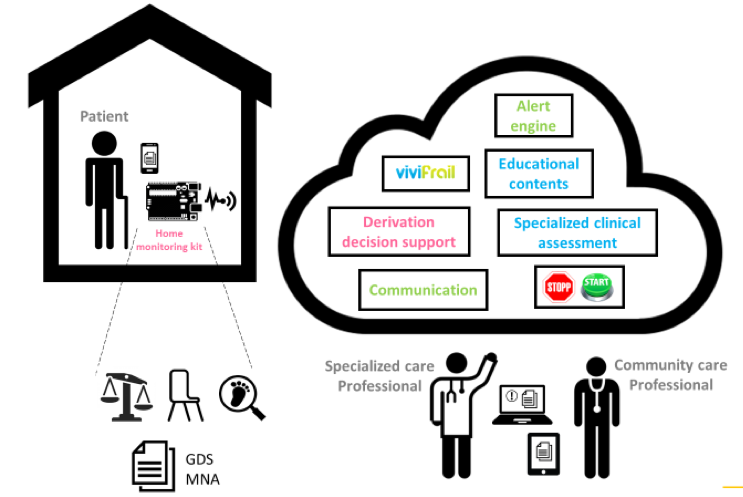
This line of research focuses, on the one hand, on unobtrusive monitoring and follow – up of the intrinsic capacity of the elderly; and on the other hand, on personalized interventions to prevent the onset of frailty, recurring falls, and disability for elderly.
Geriatric assessment is a time-consuming activity. Hospitals count with a limited workforce that is unable to manage all patients so they should focus on treating patients at higher risk. The older population must be monitored in unobtrusive and comfortable environment.
The current research line aims to create a technology able to collect relevant information at community dwelling with the following features: (i) frailty onset or worsening identification, (ii) personalized intervention according to patient health function and psychological dimensions (iii) data extraction and knowledge generation from frailty monitoring, and (iv) professional interventions and assessments.
Interventions must consider patient motivation traits and contextual information tied to patient dwelling. Such interventions involve different patient activities, including VIVIFRAIL exercise program for frailty prevention, nutrition behavior, polypharmacy reduction, and promote independence and empowerment through educational content as media, tips, and feedback from healthcare professionals, inter alia.
Accordingly, activities that includes devices and/or apps have been designed considering user-centered design and gamification strategies to minimize current generational gap between elderly and technology.

Main Results
Our main contribution in this research line is the design and deployment of an ecosystem that provides unsupervised monitoring of pre-frailty and frailty status in a community setting. To detect the onset of frailty and assess its evolution, a Comprehensive Geriatric Assessment (CGA) has been designed, compose by a holistic evaluation where physical status, mental, social, functional status are assessed. CGA includes the most relevant assessment tools: Barthel index, Lawton Index, Weight Scale, Gait Speed, Chair Stand Test, Short Physical Performance Battery, Frail Index and Fried Frailty Criteria for physical assessment; and Mini Nutritional Assessment (MNA) for nutritional status.


These tools have been deployed in order to be implemented at home. To do so, a set of hardware devices connected with mobile apps have been designed to support patient healthcare by health professionals remotely, including setup and data collection from the sensor-based devices.
The Gait Speed is a measuring device to monitor patient gait speed, an extensively test used in clinical practices. In a nutshell, the device is a pair of ultrasonic sensors deployed over a folding bar, placed at one side of a corridor, to prevent deterioration and patient injury. Ultrasonic sensors are capable to characterize the patient gait speed without supervision and able to be easily portable and installable at home. Further, the Chair Stand device monitors patient lower limb strength using motion sensors.
